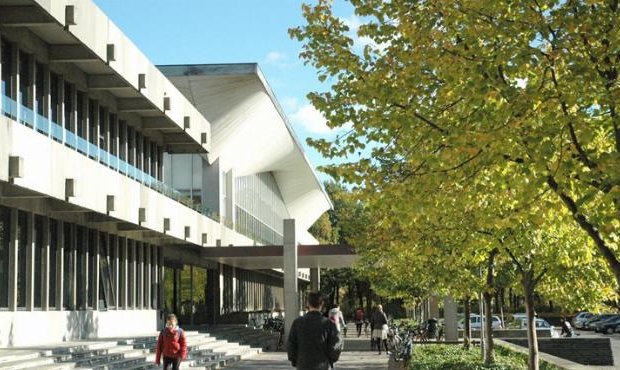
Wind was an untested green energy source when Peter Hauge Madsen started as a dedicated employee at Risø National Laboratory in the late 70s. Today, wind energy has become a global high-tech industry and Peter Hauge Madsen heads the Department of Wind and Energy Systems with almost 400 employees.
He has played a crucial role in building the current department. He was initially based at the former Risø National Laboratory, and most recently he was involved in the merger of the former DTU Wind Energy department and the Center for Electric Power and Energy. He has helped to create a solid foundation for the green transition, both at DTU and in Danish society as a whole.
Now he looks back on a career that spans 40 years. We’ve visited him at DTU Risø Campus to hear more about his working life. It’s the story of being fascinated by grassroots initiatives like the wind turbine built by amateurs in the mid-1970s in Tvind. He’s helped build up the wind turbine sector and develop a department that not only conducts research, development, and optimization of wind turbines, but also uses energy in a smarter way.
“I’ve always been convinced that wind energy is a good idea. This is probably because I’m driven by the idea that wind energy can help solve some of the world’s problems. But the fact that we’ve come so far that wind has become the main supplier of energy in large parts of the world is more than what I imagined 40 years ago,” says Peter Hauge Madsen.
A scientific purpose
His memoirs weave in and out of the department’s 40-year history. And he’s happy with that history. Because going to work isn’t just a job for him. It’s also a big part of his life. He’s filled with energy when he works in a culture where people work together to create a vision for the future. And it’s clear that he has been good at creating relationships with colleagues, business partners, and the industry, as he shows pictures from the 1980s where he is together with pioneers from the wind turbine industry and employees from the first years at Risø.
Peter Hauge Madsen has always been a curious person. At school, he tried to familiarize himself with Einstein’s theory of relativity and was fascinated by Niels Bohr’s work. But he never doubted that he wanted to be an engineer like his father.
When he started studying at DTU, it was like walking into a candy store, because there were so many exciting courses and fields of study. In the early years, he focused on general engineering skills and gained a solid foundation in mathematics and physics. He chose to become a civil engineer and went on to do a PhD in the same year. The topic was the stochastic dynamics of structures—also called random oscillations—and involved research into the peaceful use of nuclear energy, which took place at the then Risø nuclear test station.
However, after a year and a half, his career took a turn when a colleague asked for help to examine the oscillations of a wind turbine. Peter Hauge Madsen discovered that he could apply his knowledge of building principles to wind turbines.
“It was like entering a totally different world when I started working with wind power. I was surrounded by idealistic people who really wanted to make a change. Although I wasn’t as active in Tvind as some of my colleagues, I was interested in their idea of replacing oil with renewable energy and building an industry that could make Denmark independent of energy imports. It rubbed off on me. You could say it was a wake-up call. Not only was the science exciting, but it had a real purpose,” says Peter Hauge Madsen.
The test station for smaller wind turbines cirka 1981.
Harnessing solar and wind power
Denmark started opening its eyes to the importance of wind energy. After the energy crisis in the early 1970s, there was a political will to find an alternative to the traditional energy sources, and in the streets people started shouting slogans about the Barsebäck nuclear power plant in Sweden and solar and wind alternatives.
Peter Hauge Madsen was among the pioneers in the wind energy work at Risø, which later became crucial to developing the Danish wind turbine industry. Risø was granted research funds to test and analyse wind turbines to help the Danish industry get started, and the first steps were taken to develop a reliable technology for harnessing wind power. Today, you can still see some of the original structures, such as a wind turbine from the mid-1980s, which is used as a test facility, and a 125-metre-high mast used for meteorological measurements.
At the test station for small wind turbines, for example, the first prototypes were tested and smaller companies were consulted. In the same period, the foundation was laid for the Danish Wind Atlas, which has since become a global tool. Today, energy planners around the world use the atlas to get an overview of the most favourable wind conditions for wind turbines.
Other parts of the country also worked with wind turbine technologies. At Ulfborg in North Jutland, the Tvind School built a 54-metre-tall wind turbine, and in Nibe the power plants erected two demonstration turbines. At the same time, a number of inventors and small companies started developing wind turbines, which were sold to small wind turbine businesses and local enthusiasts. The inventors and turbine owners shared their experiences with the test station, which thereby gained a unique insight into the first research and development projects.
Big impact on the Danish wind industry
In the mid-80s the market for wind turbines came to a standstill, especially in the United States. In Denmark, there were several technical challenges associated with the wind turbines. And as a newly appointed head of the Test Station for Wind Turbines, Peter Hauge Madsen was called to a meeting at the Ministry of Energy and told to close the section, which at that time was funded by the Danish Energy Agency. Fortunately, this didn’t happen.
Together with representatives from the Danish wind turbine industry, Peter Hauge Madsen and his colleagues from the test station set out to change the situation. They developed a detailed Danish certification scheme based on standards that focused on the quality and safety of the wind turbine structures. In addition, they started a research programme that supported the development of wind turbine technology.
The certification scheme has since led to common international standards for how the wind turbine industry designs and tests the performance of wind turbines. This has had a big impact on the Danish wind industry because it made it easier to export and deliver turbines to the global market.
“The certification scheme meant that the test station survived and that we professionalized the entire way wind turbines are documented, developed, and calculated around the world. This had a huge effect on the technology behind international wind power and gave Risø a unique global position,” says Peter Hauge Madsen.
Wanted to save the world
After a couple of years as head of research at Siemens Wind Power in Denmark and then head of certification of offshore wind projects at DNV, he returned to DTU in 2009 as head of the Department of Wind Energy at Risø DTU. Two years earlier, Risø had become part of DTU. In 2011 it was decided to establish DTU Wind to focus on wind energy, and Peter Hauge Madsen was asked to prepare a plan for the new wind department.
In the wake of the merger, new methods of testing and demonstration were established. Today, the facilities include the Large Scale Facility, which among other things tests the strength of wind turbine blades, and the National Wind Tunnel, where DTU and industrial partners test and develop blade profiles for some of the world’s largest wind turbines with wind speeds of up to 400 km/h. In North Jutland lies Østerild Test Centre, where employees from the department test prototypes for the world’s largest wind turbines.
In parallel, the department has intensified its research partnerships with companies such as Vestas, Siemens, and LM Windpower, and established collaborations with global companies and research institutions in the wind energy field. This has shortened the path from research to application and thus sped up the development of the sector.
In 2022, DTU Wind Energy merged with the Center for Electric Power and Energy to become the Department of Wind and Energy Systems, which is one of the world leaders in the field. The vision for the new department is to accelerate the green energy transition and work for a more sustainable world. This will be done by providing sustainable solutions for integrated energy systems with wind energy as the backbone.
For Peter Hauge Madsen, it’s also time to reflect on the last 40 years. He can now lean back and see that many of the things he set out to do with his colleagues have been successful. Therefore, he will step down as head of department in March.
“It’s been important for me to be able to see a purpose, a mission with my work. And it’s satisfying that we can now see that things went as we dreamed of back in the late 70s. We’ve had a huge impact, and this is important to me. We wanted to influence the world, even help make it a better place. And I suppose I can say that we succeeded. All in all I’d say I’ve had a good and meaningful working life.”




